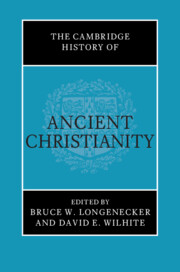Book contents
- The Cambridge History of Ancient Christianity
- The Cambridge History of Ancient Christianity
- Copyright page
- Contents
- Figures
- List of Contributors
- Editors’ Preface
- Part I Contested Contexts
- Part II Contested Figures
- Part III Contested Heritage
- Part IV Contested Cultures
- Part V Contested Beliefs
- Part VI Contested Bodies
- 24 Masculinity, Femininity, and Sexuality
- 25 Christian Slavery in Theology and Practice
- 26 Wealth, Almsgiving, and Poverty
- 27 Power, Authority, the Living, and the Dead
- Ancient Sources
- Modern Authors
- References
27 - Power, Authority, the Living, and the Dead
from Part VI - Contested Bodies
Published online by Cambridge University Press: 23 August 2023
- The Cambridge History of Ancient Christianity
- The Cambridge History of Ancient Christianity
- Copyright page
- Contents
- Figures
- List of Contributors
- Editors’ Preface
- Part I Contested Contexts
- Part II Contested Figures
- Part III Contested Heritage
- Part IV Contested Cultures
- Part V Contested Beliefs
- Part VI Contested Bodies
- 24 Masculinity, Femininity, and Sexuality
- 25 Christian Slavery in Theology and Practice
- 26 Wealth, Almsgiving, and Poverty
- 27 Power, Authority, the Living, and the Dead
- Ancient Sources
- Modern Authors
- References
Summary
In his treatise On the Soul, Tertullian remarks on certain long-established beliefs that a part of the soul survived the body after death. He explains that the practice of keeping a portion of the deceased body intact rather than cremating it with the rest of the corpse is intended to maintain a place for the soul’s continued habitation:
But not a particle of the soul can possibly remain in the body, which is itself destined to disappear when time annihilates the body’s entire sphere of action. And yet, because some still hold the belief in a partial survival of the soul, they will not permit burning of the dead body, in order to spare that small residue of the soul.1
- Type
- Chapter
- Information
- The Cambridge History of Ancient Christianity , pp. 633 - 658Publisher: Cambridge University PressPrint publication year: 2023



